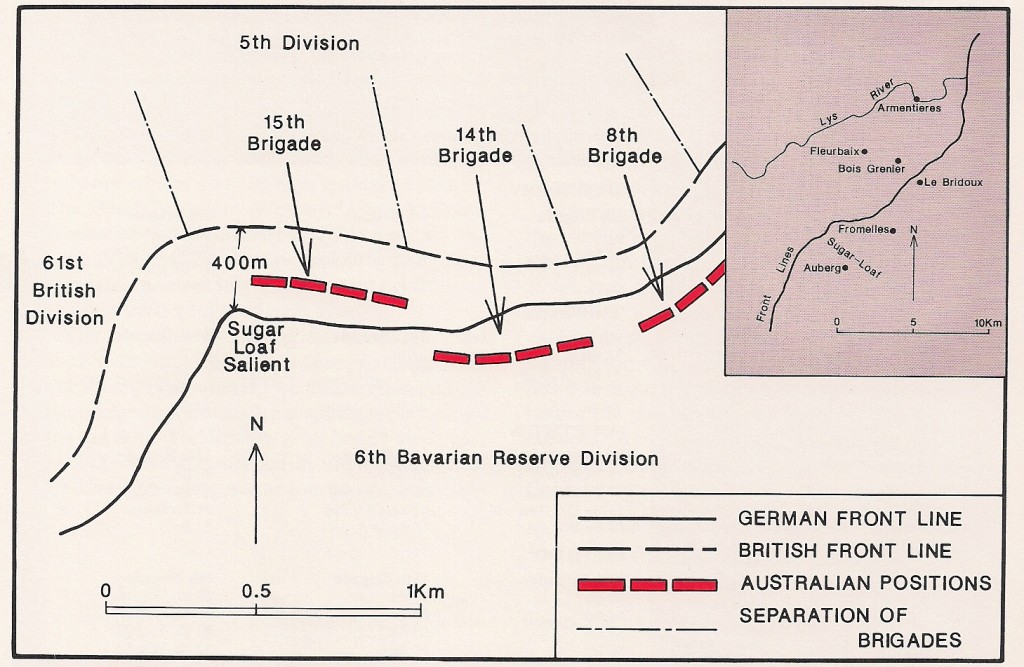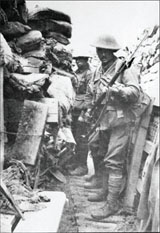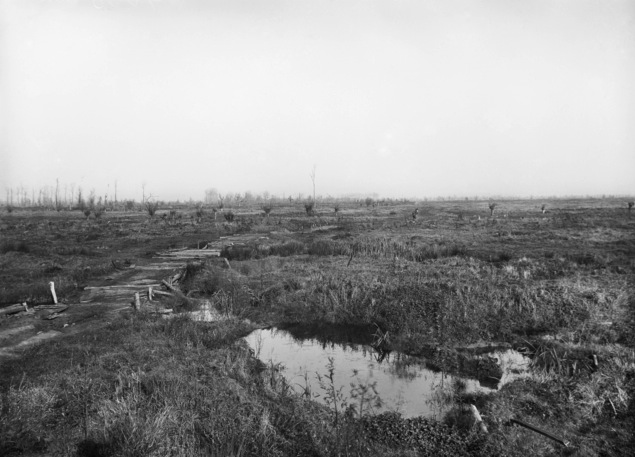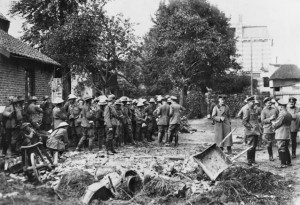The Battle of Fromelles Revisited
Historical Highlight
Dedicated readers of Battlefield News would recall our first look at the battle of Fromelles, in July two years ago. It was a brief look but it came with the undertaking to follow up the AIF experience on the Western Front in more detail, as we got closer to the centenary of the actions of 1916 and beyond. This month we begin that exploration by revisiting the events of 19 and 20 July 1916. Fromelles was the first major battle fought by the AIF on the Western Front, the doubtful honour going to the three brigades of the 5th Australian Division. Recently arrived in France, the division had been raised in Egypt in February 1916 as part of the expansion of the AIF. It was commanded by Major General James McCay who, as a colonel, had taken the 2nd Brigade ashore at Gallipoli. A lack of equipment meant that the division had not completed brigade level or combined arms training (i.e. coordinated training with supporting artillery) before the redeployment to France. The inexperience of the supporting Australian gunners was to be a factor at Fromelles. The purpose of the attack was to prevent the Germans from redeploying reserves from this sector of the front to the area of the Somme, where a major allied push had been in progress since 1 July. To achieve this, two divisions - the Australian 5th and the British 61st – would attack, side by side, on a 4,000 metre frontage. In a departure from the normal practice Headquarters XI Corps, responsible for conduct of the attack, directed the two divisions to attack with all three of their brigades in line, instead of retaining the third brigade as a reserve. The positions confronting the Australians were in the Aubers Ridge sector, occupied by the 6th Bavarian Reserve Infantry Division. Although not significantly high, the ridge provided a commanding view of the surrounding countryside, particularly over the allied
The positions confronting the Australians were in the Aubers Ridge sector, occupied by the 6th Bavarian Reserve Infantry Division. Although not significantly high, the ridge provided a commanding view of the surrounding countryside, particularly over the allied  lines, opposite and the Bavarians had been in occupation for over a year. Lessons learned from fighting the British in the same area in 1915 had led the Germans to develop a defensive layout in three zones, incorporating steel and concrete strongpoints. This provided the depth to absorb any penetration before launching coordinated counterattacks. An additional defensive feature was the creation of salients, projecting out from the front line. Heavily fortified, these allowed enfilading machinegun fire to be directed on infantry assaulting either side of the salient.
lines, opposite and the Bavarians had been in occupation for over a year. Lessons learned from fighting the British in the same area in 1915 had led the Germans to develop a defensive layout in three zones, incorporating steel and concrete strongpoints. This provided the depth to absorb any penetration before launching coordinated counterattacks. An additional defensive feature was the creation of salients, projecting out from the front line. Heavily fortified, these allowed enfilading machinegun fire to be directed on infantry assaulting either side of the salient.
 In accordance with the corps orders, McCay placed the 8th Brigade on the left and the 14th Brigade in the centre of his attack frontage. The 15th Brigade was on the right, adjacent to the inter-division boundary with the 61st Division. A major mistake in the XI Corps planning placed this boundary through the centre of the Sugarloaf feature, a significant salient in the Bavarian front line. This left flanking units of the two divisions responsible for different parts of a key objective – something that was to have disastrous results for the 15th Brigade.
Problems developed well before the attack began. The 5th Division was in another part of the line and had to move into position during daylight on 19 July. Under observation from the Germans on the high ground, this move received heavy artillery fire which continued once the men were in the front line. For the 8th and 14th Brigades this was compounded by friendly fire, from the inexperienced Australian gunners, falling short onto their positions.
In accordance with the corps orders, McCay placed the 8th Brigade on the left and the 14th Brigade in the centre of his attack frontage. The 15th Brigade was on the right, adjacent to the inter-division boundary with the 61st Division. A major mistake in the XI Corps planning placed this boundary through the centre of the Sugarloaf feature, a significant salient in the Bavarian front line. This left flanking units of the two divisions responsible for different parts of a key objective – something that was to have disastrous results for the 15th Brigade.
Problems developed well before the attack began. The 5th Division was in another part of the line and had to move into position during daylight on 19 July. Under observation from the Germans on the high ground, this move received heavy artillery fire which continued once the men were in the front line. For the 8th and 14th Brigades this was compounded by friendly fire, from the inexperienced Australian gunners, falling short onto their positions.
 The seven-hour preparatory bombardment lifted at 6.02 pm and the 15th Brigade troops on the right, with the widest part of No Man’s Land to cross, were caught in the open. The Sugarloaf position had not been destroyed
by the bombardment and the machineguns there shattered the infantry advance. The right of the Australian attack stalled at this point as the men sought whatever cover was available in front of the German line. The few who made it into the trenches were quickly overwhelmed.
In the centre men of the 14th Brigade, despite also receiving enfilade fire from the Sugarloaf, managed to break through the German front line and advance as far as the second line. Drawn deeper into the defence by the search for their objective - the German support line - the attack became disorganised. Discovering that there was no actual support line and under increasing pressure, the survivors of the 14th Brigade set up a defensive position within the part of the German second line they had captured and struggled to hold out.
The 8th Brigade assault on the left broke through the front line and, pushing on, also discovered that their support line objective did not exist. The enemy moving in behind their exposed position forced a withdrawal to the German second line where they set up a defensive position, in line with and about 300 metres from the 14th Brigade position to the right.
In a final tragedy for the 15th Brigade, a composite force of several companies was destroyed while trying to support an attack by the 61st Division on the Sugarloaf salient. In the confusion of the battle the attack had been ordered, then cancelled, but the 15th Brigade was not informed.
The focus of the Australians now was on reinforcing and resupplying the positions being held within the German lines. Desperate efforts to dig communications trenches across No Man’s Land were halted by German artillery and by the machineguns in the Sugarloaf position which still hadn’t been captured. The resupply effort was hindered by a lack of men available as carriers and by the fact that those who did arrive in the isolated pocket were co-opted into its defence. Determined German counter-attacks throughout the night gradually collapsed the flanks of the Australian position. In pushing through the German front line in search of objectives in depth, the Australians had left those trenches unoccupied. Now they found the Germans moving between and around the Australian-held parts of the second line to reoccupy their former front line and cut off any avenue of retreat.
By the early morning of 20 July the situation was beyond recovery. Ammunition was running very low and the reinforcement and resupply effort was exhausted. At 3.45 am the survivors of the 8th Brigade broke out and returned to the Australian lines. At 7.50 am what was left of the 14th Brigade was ordered to withdraw.
Australian losses in the battle were 5,533 officers and men killed, wounded or taken prisoner. The 5th Division would be combat ineffective for several months. The British 61st Division had 1,547 casualties, while the Germans had 1,582 casualties, half of them in the regiment opposing the Australians.
The seven-hour preparatory bombardment lifted at 6.02 pm and the 15th Brigade troops on the right, with the widest part of No Man’s Land to cross, were caught in the open. The Sugarloaf position had not been destroyed
by the bombardment and the machineguns there shattered the infantry advance. The right of the Australian attack stalled at this point as the men sought whatever cover was available in front of the German line. The few who made it into the trenches were quickly overwhelmed.
In the centre men of the 14th Brigade, despite also receiving enfilade fire from the Sugarloaf, managed to break through the German front line and advance as far as the second line. Drawn deeper into the defence by the search for their objective - the German support line - the attack became disorganised. Discovering that there was no actual support line and under increasing pressure, the survivors of the 14th Brigade set up a defensive position within the part of the German second line they had captured and struggled to hold out.
The 8th Brigade assault on the left broke through the front line and, pushing on, also discovered that their support line objective did not exist. The enemy moving in behind their exposed position forced a withdrawal to the German second line where they set up a defensive position, in line with and about 300 metres from the 14th Brigade position to the right.
In a final tragedy for the 15th Brigade, a composite force of several companies was destroyed while trying to support an attack by the 61st Division on the Sugarloaf salient. In the confusion of the battle the attack had been ordered, then cancelled, but the 15th Brigade was not informed.
The focus of the Australians now was on reinforcing and resupplying the positions being held within the German lines. Desperate efforts to dig communications trenches across No Man’s Land were halted by German artillery and by the machineguns in the Sugarloaf position which still hadn’t been captured. The resupply effort was hindered by a lack of men available as carriers and by the fact that those who did arrive in the isolated pocket were co-opted into its defence. Determined German counter-attacks throughout the night gradually collapsed the flanks of the Australian position. In pushing through the German front line in search of objectives in depth, the Australians had left those trenches unoccupied. Now they found the Germans moving between and around the Australian-held parts of the second line to reoccupy their former front line and cut off any avenue of retreat.
By the early morning of 20 July the situation was beyond recovery. Ammunition was running very low and the reinforcement and resupply effort was exhausted. At 3.45 am the survivors of the 8th Brigade broke out and returned to the Australian lines. At 7.50 am what was left of the 14th Brigade was ordered to withdraw.
Australian losses in the battle were 5,533 officers and men killed, wounded or taken prisoner. The 5th Division would be combat ineffective for several months. The British 61st Division had 1,547 casualties, while the Germans had 1,582 casualties, half of them in the regiment opposing the Australians.
 The battle of Fromelles showed how much the new Australian formations still had to learn about warfare on the scale of the Western Front. The plan was flawed, the preparation inadequate and the artillery support ineffective and, in the event, the sacrifice had no effect on the outcome of the Somme offensive.
In a long-delayed postscript, on the 94th anniversary of the Battle of Fromelles, the last of 203 Australian soldiers recovered from the Pheasant Wood mass burial site were buried with full military honours in the new Fromelles Cemetery.
Article written by Rod Margetts - who is a battlefield tour guide for Boronia Travel Centre.
Map: The Battle of Fromelles Part 1: Artillery Bombardment.
Source: thomascarrucan.blogspot.com
Image middle right: A typical German pillbox in the German line on the summit of Fromelles Ridge. From this and adjacent positions a devastating fire was poured upon the troops of the 5th Australian Division in the abortive battle of Fromelles on 19 July 1916. The pillbox has grass grown over its roof and around its sides, probably for camouflage, and on its side a sign with the word 'Ortrud'. Source: AWM.
Image middle left: Men of the 53rd Battalion, 14th Brigade minutes before leaving the safety of their trench for the attack. Source: AWM.
Image bottom right: The old no man's land of Fromelles battlefield viewed from the north-east corner of Sugar Loaf Salient looking towards the line from which the 15th Australian Infantry Brigade began their attack on 19 July 1916. During the engagement the 5th Division, penetrated the third German line, but was forced to withdraw owing to German troops flooding the ditches in which the Australians had entrenched and to the exposure of the flank to heavy artillery and machine gun fire. Source: AWM.
Image bottom left: Australian prisoners of war arriving at the German collecting station on the morning of 20 July during the Battle of Fromelles which took place on 19 July 1916 and 20 July 1916. The German officer, second from the right with hand to breast, gave this photo with others, to Captain C Mills of the 31st Battallion at Berlin after the armistice. Source: AWM.
The battle of Fromelles showed how much the new Australian formations still had to learn about warfare on the scale of the Western Front. The plan was flawed, the preparation inadequate and the artillery support ineffective and, in the event, the sacrifice had no effect on the outcome of the Somme offensive.
In a long-delayed postscript, on the 94th anniversary of the Battle of Fromelles, the last of 203 Australian soldiers recovered from the Pheasant Wood mass burial site were buried with full military honours in the new Fromelles Cemetery.
Article written by Rod Margetts - who is a battlefield tour guide for Boronia Travel Centre.
Map: The Battle of Fromelles Part 1: Artillery Bombardment.
Source: thomascarrucan.blogspot.com
Image middle right: A typical German pillbox in the German line on the summit of Fromelles Ridge. From this and adjacent positions a devastating fire was poured upon the troops of the 5th Australian Division in the abortive battle of Fromelles on 19 July 1916. The pillbox has grass grown over its roof and around its sides, probably for camouflage, and on its side a sign with the word 'Ortrud'. Source: AWM.
Image middle left: Men of the 53rd Battalion, 14th Brigade minutes before leaving the safety of their trench for the attack. Source: AWM.
Image bottom right: The old no man's land of Fromelles battlefield viewed from the north-east corner of Sugar Loaf Salient looking towards the line from which the 15th Australian Infantry Brigade began their attack on 19 July 1916. During the engagement the 5th Division, penetrated the third German line, but was forced to withdraw owing to German troops flooding the ditches in which the Australians had entrenched and to the exposure of the flank to heavy artillery and machine gun fire. Source: AWM.
Image bottom left: Australian prisoners of war arriving at the German collecting station on the morning of 20 July during the Battle of Fromelles which took place on 19 July 1916 and 20 July 1916. The German officer, second from the right with hand to breast, gave this photo with others, to Captain C Mills of the 31st Battallion at Berlin after the armistice. Source: AWM.
This entry was posted in Historical Highlights. Bookmark the permalink.






